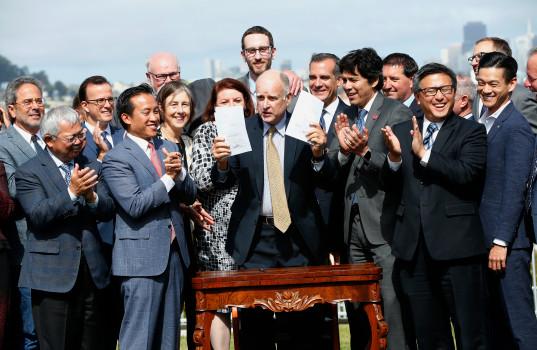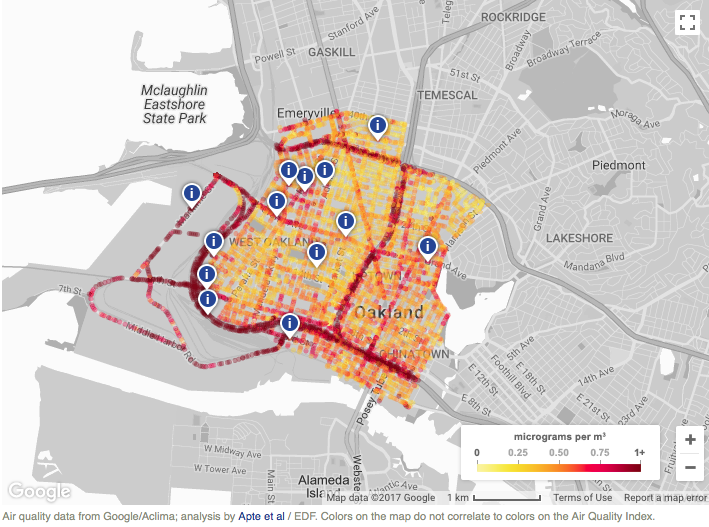Santa Cruz Real Estate
Digest,
Ed. 26
|
|
|
|
|
|
October, 2017 - In This Issue:
|
|
|
|
|
|
In This Month's Issue
|
|
In this month's Digest you will find national and local news as well as informational pieces on topics that we have found to be important in today's real estate industry.
In December of 2016, we wrote about the passage of Prop 64 which will eventually allow for the
cultivation and sale of commercial cannabis in the state of California. Read below for a follow up on this topic.
Many consider the purchase of a manufactured or mobile homes in Santa Cruz County as a more affordable option. If you are one of those people, our second article is for you!.
More than a dozen bills designed to address the growing housing crisis in the California were signed into law on September 29th, 2017. Learn more in this month's third article.
If we could see air pollution, would we be more proactive about combatting it? Christine reviews an ongoing,
Google sponsored project that could change the way we think about air pollution. Read about it in Christine's Corner.
|
|

Real Estate Market Statistics
For Santa Cruz, Santa Clara, and
Monterey
The reports contain median home prices, real estate price statistics, valuable information about mortgage rates and much more.
|
Update: New Cannabis Laws and Real Estate
Back in December of 2016, we wrote about the consequences of the successful passage of Prop 64 which will eventually allow for the sale and taxation of commercial cannabis in the state of California.
This article is a follow up on this topic.
To legally cultivate cannabis, both a state and local license will be required. How does one obtain these licenses? In both levels of government, regulations are still being formed. Here is an update on where the California and Santa Cruz County are in this process:
California Licensing
The
Bureau of Medical Cannabis Regulation
(BMCR) is the lead agency in developing regulations for medical and adult-use cannabis in California.
CalCannabis Cultivation Licensing
, a branch office within the California Department of Food and Agriculture (CDFA), is responsible for developing regulations to license cultivators of these two types of cannabis.
Business and Professions Code section 26050.1 allows the Bureau to issue temporary licenses, which allows a business to engage in commercial cannabis activity for a period of 120 days. The Bureau can only issue a temporary license if the applicant has a valid license, permit, or other authorization issued by the local jurisdiction. Find temporary license application information
here
.
Because of the stipulation that a local license must be obtained prior to a state license, the legal cultivation of commercial cannabis will be subject to the county's legislative timeline.
Santa Cruz County Licensing
At the county level, the Santa Cruz County Board of Supervisors has formed the Cannabis Licensing Office, which has the task of developing local regulations after the passage of Prop 64. The county has commissioned an Environmental Impact Report (EIR) for two proposed cannabis ordinances, County Code 7.128 Commercial Cannabis
Cultivation
, and County Code 7.132 Commercial Cannabis
Manufacture
. Read more about the EIR process
here
. Until a replacement ordinance is enacted, the current local law states that commercial scale cannabis cultivation for recreational use is currently not allowed in Santa Cruz County.
You will note that the proposed draft ordinance on the cultivation of commercial cannabis seen above is solely focused on the cultivation of medical cannabis. This is because this draft was written before the passage of Prop 64, and so the cultivation of recreational cannabis was not yet considered. According to a representative of the Santa Cruz County
Cannabis Licensing Office
, the intent is to strike the word "medical", where it occurs, in this draft ordinance before its final passage. There will also be updates to the current dispensary laws which will allow local dispensaries to sell recreational marijuana. These changes to dispensary related laws will probably be out by the end of this year and the cultivation ordinance is expected to be completed sometime around March of 2018.
Currently the board is in a public comment period, in which members of the public can send thoughts and recommendations to the Planning Department before the next round of ordinance-review beings. Follow this
link
to see where to submit a comment.
|
What to Consider When Buying
A Manufactured (Mobile) Home
Have you ever considered buying a manufactured or mobile home in Santa Cruz County? This article covers important topics on manufactured and mobile home ownership, including financing and the appreciation-potential of your asset.
First, a small but important detail is the differences between mobile and manufactured homes. Most people use the two terms interchangeably, but it turns out there is a difference. In 1976, stricter standards were put in place for the construction of mobile homes and with these codes came a name change - all mobile homes built after July 15, 1976 are called manufactured homes. The HUD code that was enacted in 1976 involved regulating the quality of all aspects of building manufactured homes, including:
-
Design and construction
-
Strength and durability
-
Transportability
-
Fire resistance
-
Energy efficiency
-
Overall quality
If you are considering buying a mobile home, that is a structure that was build prior to 1976, keep in mind that it may not contain all of the safety and efficiency features of a manufactured home.
What Mobile and Manufactured homes have in common is they are both built on a permanent chassis and have wheels for transport, which are detached when the home reaches its location. It's possible to move the home elsewhere, but the area must be zoned for that particular home structure type. See a list of all mobile and manufactured homes in the county
here
. Note: in this document, ROP, or resident owned park applies to both subdivided parks and co-op owned parks.
For simplicity, for the remainder of the article we will use "manufactured homes" unless there is a difference in the information given between mobile and manufactured homes.
Financing a Manufactured Home Purchase:
The ownership of the land underneath the manufactured home is an important determinant of your loan options. There is currently only one kind of conforming loan on manufactured homes, which requires that the home rest on real property (meaning the park is subdivided). In other words, the homeowner owns the land underneath their home rather than leasing it or belonging to a co-op which owns the land. According to the County Assessor's Office, only five mobile home parks in the county are subdivided: Aptos Pines, Brookvale Terrace, Montevalle (55+), Tradewinds (55+), and Turner Lane. To discuss your loan options in a subdivided park, we recommend that you contact Ryan Buckholdt: 831.600.1590.
Conforming loans are, in general, more attractive to lenders because they can sell your mortgage on the secondary market. Because non-conforming loans are riskier, your loan terms may be less favorable if you are buying in a leasehold or co-op park. There are fewer lenders in Santa Cruz that offer mortgages in non-subdivided parks. For your convenience, we have gathered the name of lending institutions that will lend on these kinds of manufactured homes
here
. Two well known lenders in town that will lend on leased or co-oped owned land are Bay Federal Credit Union and Santa Cruz Community Credit Union. Read more about their programs below. Note that these loan terms are subject to change.
BayFed:
BayFed manufactured home loans require 20% down on co-op land and 25% on lease land parks. They only do 20 year terms and interest rates are fixed and typically fall in the 5% to low 7% range depending on the creditworthiness of the lender. Click
here
for a list of parks that BayFed will lend on and read more about the program
here
. We have a preferred lender within BayFed, and so if you would like a referral, please let us know.
Santa Cruz Community Credit Union:
Similarly, Santa Cruz Community Credit Union (SCCCU) requires 20% down, plus closing costs. The loan-term is 20 years and they have no prepayment penalties. The interest rates are also fixed and can be as low as 5.5% and as high as 10.5%. Borrowers can refinance at any time, but there will be additional closing costs.
SCCCU only finances in Santa Cruz County and the home needs to be 20 years or younger (which excludes mobile homes). They are able to lend to people with I10's, meaning it is not necessary to have a social security number to obtain a mortgage. Read more about their program
here
. To see a list of parks that they will lend on, you will need to visit a local branch.
Manufactured Homes and Appreciation:
A negative stereotype about manufactured homes often steers buyers away: they tend to appreciate slower than stick-built homes, or worse, depreciate. Is this true?
In 2003, Consumers Union researched this question (see the report
here
). Their analysis included an extensive literature review of previous work in the field, as well as primary research using data from the 1985-1999 American Housing Survey Panel and county appraisal data from three counties in Texas. Their analysis showed that manufactured home buyers may be able to make decisions which can improve the appreciation-potential of their investment. For example, in the study, land ownership, location, purchase price and maintenance expenditures are among the factors that predicted appreciation. On the whole manufactured homes appreciated 6% less a year than site built homes, but those packaged with the land appreciated similarly to site built homes. On average manufactured homes on leased land depreciated.
Overall, the answer to this question is not straightforward, and in a location like Santa Cruz County, owning a manufactured home and the land underneath, in a highly desirable location is likely a good investment. However, the only way to really know would be to research the park you are interested in buying in. By analyzing sales-price trends and comparing them to average appreciation rates in the neighborhood, you can start to understand the investment-potential of a manufactured home in a given area.
We have monthly and annual local market data throughout the county and can help you with this analysis. If you are considering buying a manufactured home in Santa Cruz County, give us a call.
|
Legislative Corner

According to this
article
, more than a dozen bills designed to address the growing housing crisis in the California were signed into law on September 29th, 2017. These bills (15 in total) approach the crisis in a variety of ways. For example, Bills 166 and 167 are focused on streamlining the development process. Senate Bill 2 creates a permanent source of funding for affordable housing by, amongst other things, imposing a $225 fee on certain real estate transactions such as refinancing a mortgage. Assembly Bill 1505 allows local governments to require developers to include affordable rental units.
While commendable, this is just the beginning. As seen in the chart below, California needs 180,000 new homes each year to keep up with a growing population. It's estimated that these 15 legislative bills will add an additional 14,000 to the 100,000 currently being built. As members of the California Association of Realtor, we will continue to advocate for legislation aimed at increasing affordable housing without decreasing the advantages of homeownership.

|
Christine's Corner

If we could see air pollution, would we be more proactive about combatting it?
Project Air View
is bringing Google and experts from various backgrounds together to map air pollution throughout California. Initially, Google teamed up with a San Francisco-based startup, Aclima, to map air-pollution levels throughout Oakland. Their team found that pollution tends to concentrate in specific "hot spots", and within a single block air pollution levels can vary dramatically. From these findings, researchers have created an
interactive map
to illustrate their findings.
Proj
ect Air View is hoping to expand this research throughout California, and possibly beyond.
Google's Street View cars are already driving around the country, and with new technology that can collect air pollution levels from the top of these cars, this project will likely scale up quickly. It may be that one day, while checking the weather from our smartphones, we will also be able to check the air quality on our block.
What are the implications for real estate decision making? In the future could property-pricing take air pollution measurements into account? Would this motivate entire neighborhoods to proactively combat air pollution?
Only time will tell. Until then, read more about this topic
here
.

|
|
|
|
|